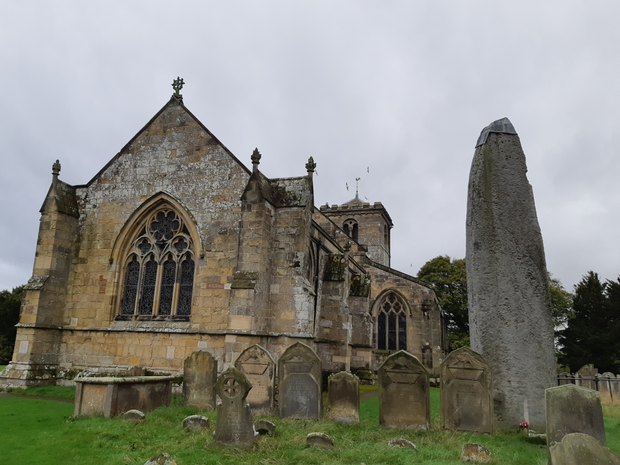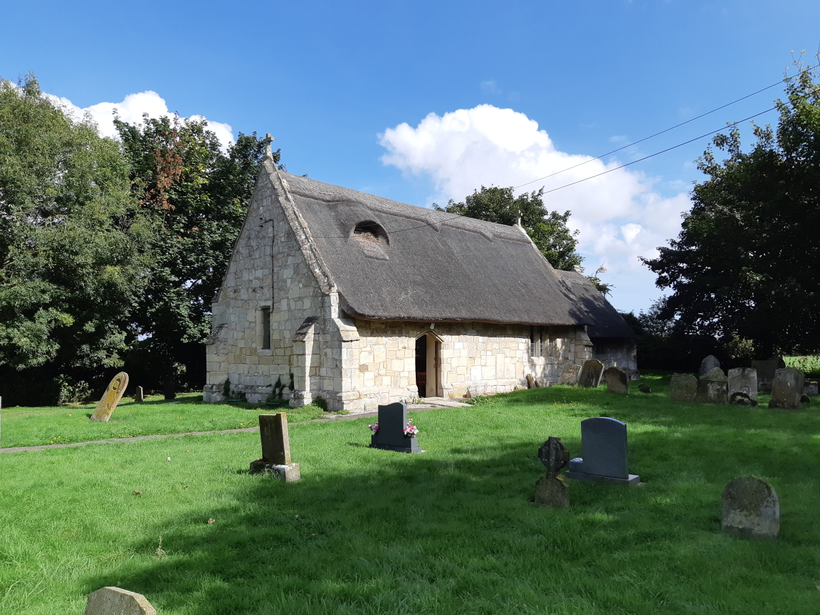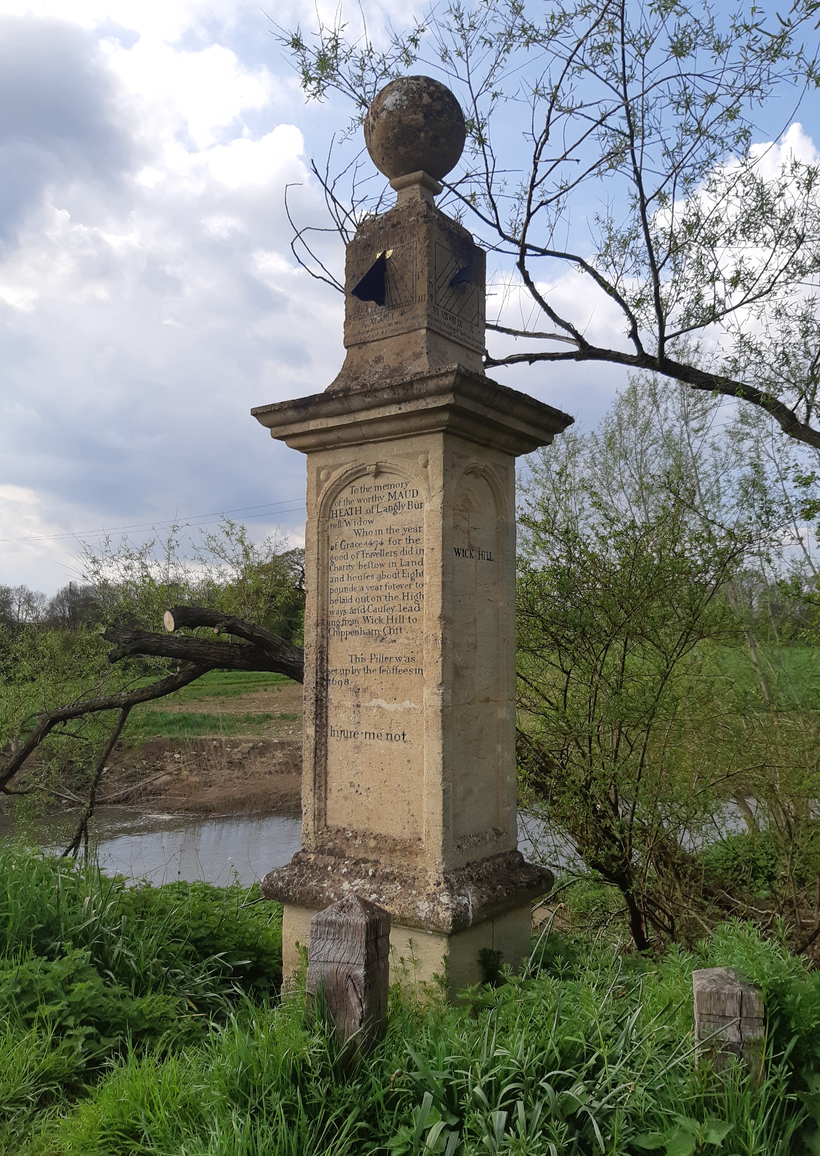Rudston is a tiny village in the East Riding of Yorkshire, with a population that barely exceeds 400. Yet, in its churchyard, sits Britain’s tallest megalith. The standing stone towers over the graves and mundanity of the church structure, piercing through the grass like an enormous stone needle. The sheer size of the stone, and the incongruity of its presence in the churchyard is decidedly arresting; it doesn’t make sense and, if you read as much 70s folk horror as I do, it’s really rather threatening. With church and neolithic monolith side by side, it’s clear to see that Rudston has been the site of ritual and worship for centuries.





The parish church of All Saints dates from around 1100AD, and was built by William Peverel, Lord of the Manor. Today, only the tower remains of this early Norman church, as hefty renovations down the centuries have left their mark. Extended in the 13th century with substantial alterations made during the Victorian period, some of the original stonework can still be deciphered in the walls at the west end of the church. From this Victorian period comes the church’s equally monolithic organ – an instrument so large, that it dominates the space and is commemorated with gusto in most church guidebooks.

Now, I love a good font and Rudston did not disappoint. Their cylindrical font with ‘alternating circle and lozenge adornment’[1] dates from the 12th century and is a striking, unusual design, rather like a fancy rolling pin.

There are also a great number of beautiful wall memorials within the church, including a stunning alabaster relief carving for Richard and Susan Belmont. Their likenesses are captured in cameos, held by two weeping angels.

Another similar sculptural memorial belongs to Godfrey Wentworth Bayard Bosville Esq – ‘de jure Macdonald of the Isles, 13th Baronet – who died in 1865 aged 40. The Macdonalds are a prominent landowning family of the county, and many of their descendants reside in the churchyard.

However, for all of the church’s ecclesiastical beauty, the graveyard is a source of amazing social history. The Yorkshire author Winifred Holtby – known for her posthumously-published novel South Riding (1936) – is buried at Rudston. A lifelong friend of Vera Brittain, Holtby was a farmer’s daughter turned socialist, feminist and pacifist, who went on to lecture for the League of Nations and campaigned for the unionisation of black workers in South Africa.



She died aged 37 from Brights Disease (acute nephritis), having never married, but crammed so much into her short, brilliant life. In her will, Holtby bequeathed her book collection to a library in a small South African township, which was opened under the name ‘The Winifred Holtby Memorial Library’ and was the first library to be built in Africa for non-Europeans. An additional memorial plaque to Holtby can be found within the church.


The most visually arresting memorial to the rear of the churchyard is the grave of Alistair John, the son of Martin and Margaret Thompson who died on the 5th October 1955, aged just 10. In a poignant tribute to lost youth, the likeness of Alistair is rendered beside the stone, a few feet high and dressed in his Sunday best.

As with many churchyards close to the coast, there are several headstones marked with the seafaring occupation of the deceased, such as James Shepherd, Master Mariner, who died in 1826 aged 29. Also, this beautiful captain’s grave features crossed iron anchors, the likes of which I have never seen before.


There’s also a nice selection of graves with intact wrought iron railings – the likes of which are rarely seen intact in England, owing to the (largely pointless) WWII iron drive that saw much of our beautiful railings and decoration torn up and removed for a vague sense of community effort in wartime.

Curiously, one family plot is surrounded by railings, but is the strangest shape, looking rather like someone trying to push the boundaries of their neighbour’s property line, than a place for eternal rest.


Another beautifully fenced grave is the gothic plot of Mary Catharine Harding, who died in 1875, aged 65. With such vast, unused space beside her, we can only assume that her wish to be buried alongside her family was never to be fulfilled. There’s always something doubly mournful and strangely curious about finding largely-empty family plots. Was there a fall-out? Did someone remarry? Was there scandal? We can only imagine. One thing we CAN be sure of though, if that Mary’ grave is absolutely gorgeous and I demand a replica for myself.

The only commonwealth war grave I found on site was to J. Etherington of the Yorkshire Regiment who died on 15th August 1917, aged 32.
‘3rd Battalion Yorkshire Regiment. Son of Joseph Etherington, of Barnard Castle, Co. Durham; husband of Charlotte A. Etherington, of Salisbury Terrace, Bridlington, Yorks. Died at home 15 August 1917. Aged 32.
Born Barnard Castle (Durham), Enlisted Redcar.’[2]

In my search for grave mistakes (gettit?) I also came across this headstone to William Foster…Forster…Foster…no, wait? Either way, he was a farmer from Little Thorp and died in 1854, and was commemorated with a spelling mistake. I can absolutely imagine the same happening to me, and coming back to haunt the mason, screaming ‘TWO R’S TWO L’S’.



There have been a great number of ancient burial sites discovered around the local area, with even more lost to the destructive process of ploughing. Its believed that over the centuries, hundreds of long and round barrows have been lost, and at least one important henge – all to either agricultural need or Christian destruction. Although Rudston is a tiny dot on the map today, it’s clear that it had great importance for many native and invading cultures.

However, we may mourn the loss of ancient burials, but one small revenant remains at the back of the churchyard. Providing you don’t mind getting half-way into a hedge and wrecking your shoes, there’s the remains of a double cist (a square, stone grave) that was placed at the site following its removal from the nearby Rudston Beacon (a small hill and the place of many neolithic burials) in the 19th century.


The grey sandstone megalith measures about 8 metres high, 2 metres wide and is estimated to weigh approximately 26 tons. It’s believed that the stone was set into place at Rudston around 1600BC; considering Rudston was Christianised in 1100AD, this means that the stone may have stood proudly on this spot for nearly 3000 years. One theory is that the stone was quarried and transported from the hills at Cleveland, to the west of Whitby; driving this distance today would take over an hour and a half, so the original journey of the monolith would have been far longer and more perilous, especially considering the dangerous landscape of the moors. Other sources believe it may have been Cayton Bay, south of Scarborough; still, quite the distance!

One unusual feature of the monolith is that it has a little hat. This 18th century lead cap was an early attempt to deter erosion, and although the stone was already slightly fluted from centuries of rainfall, it appears to have helped slow down this process.


Today, the monolith represents different things to the varying communities who maintain and visit the site. Some use it as an offering stone or altar for a variety of pagan beliefs, others see it as a churchyard curiosity, and some revere it with the same Christian sanctity they apply to the church itself. During my visit, I found many offerings of nuts, shells, beads, coins, pebbles even a letter. I also made sure not to dislodge anything left behind, as the site felt very powerful and communal, and certainly not for an individual to police.

Ruston is a very unusual place, and well worth the drive. The long and jarring relationship between ‘old’ and ‘ancient’ is one rarely seen in existing sites of Christian worship, and the general ‘feeling’ around the quiet churchyard and monolith is something quite special, and powerful, indeed.


***

Liked this post? Then why not join the Patreon clubhouse? From as little as £1 a month, you’ll get access to tonnes of exclusive content and a huge archive of articles, videos and podcasts!
Pop on over, support my work, have a chat and let me show you my skulls…www.patreon.com/burialsandbeyond

Liked this and want to buy me a coffee?
To tip me £3 and help me out with hosting, click the link below!
https://ko-fi.com/burialsandbeyond
***
[1] https://historicengland.org.uk/listing/the-list/list-entry/1162387?section=official-list-entry
[2] http://www.ww1-yorkshires.org.uk/html-files/cemeteries/rudston-cemetery.htm




Leave a comment